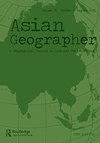青藏高原东北干旱区青海云杉对近期气候变暖的差异生长响应
IF 2.2
Q2 GEOGRAPHY
引用次数: 2
摘要
北半球高海拔森林树木生长对气候变化的不同响应已被广泛报道。本文在青藏高原东北部干旱地区不同热液条件下的3个样地(DHS、XXG和TLC)建立了青海云杉(Picea crassifolia)的树轮宽度(TRW)和最大晚木密度(MXD)年代学,并利用这些年代学观察了青海云杉的气候-生长关系和不同的生长响应。交叉相关表明,TRW和MXD年表存在高度显著的差异。在不同的云杉树种中,降水与TRW的关系最为密切。在上树线样地(XXG)和生长受温度限制的相对湿润样地(TLC), MXD随时间的增长趋势相似。在干旱点(DHS), TRW表现出强烈的干旱胁迫信号,而MXD对温度变化失去敏感性。我们想强调的是,有必要对正在经历气候变暖的树木可能的非平稳生长响应进行更多的研究,特别是对用于干旱地区温度重建的干燥地点的MXD进行研究。本文章由计算机程序翻译,如有差异,请以英文原文为准。
Divergent growth response of Qinghai spruce to recent climate warming in the arid northeastern Tibet Plateau
ABSTRACT Divergent responses of tree growth to climate change have been widely reported from the high altitude forests of the Northern Hemisphere. Here, we developed tree-ring width (TRW) and maximum latewood density (MXD) chronologies for the Qinghai spruce (Picea crassifolia) from three sites (DHS, XXG, and TLC) with different hydrothermal conditions in the arid northeastern Tibetan Plateau, and we used these chronologies to observe climate-growth relationships and divergent growth responses of the Qinghai spruce. Cross correlations showed highly significant divergences among the TRW and MXD chronologies. Precipitation was most strongly related to TRW in different spruce trees. At the upper treeline site (XXG) and at the relatively wet site (TLC), where growth was limited by temperature, MXD showed similar growth trends over time. At the dry site (DHS), TRW showed a strong drought stress signal over time, and MXD lost sensitivity to temperature variations. We would like to highlight the necessity for additional studies investigating possible non-stationary growth responses of trees that are experiencing climate warming, especially for studies of MXD at dry sites that are used for temperature reconstruction in arid areas.
求助全文
通过发布文献求助,成功后即可免费获取论文全文。
去求助
来源期刊

Asian Geographer
GEOGRAPHY-
CiteScore
3.30
自引率
0.00%
发文量
7
期刊介绍:
Asian Geographer disseminates knowledge about geographical problems and issues focusing on Asia and the Pacific Rim. Papers dealing with other regions should have a linkage to Asia and the Pacific Rim. Original and timely articles dealing with any field of physical or human geographical inquiries and methodologies will be considered for publication. We welcome, for example, submissions on people-environment interactions, urban and regional development, transport and large infrastructure, migration, natural disasters and their management, environment and energy issues. While the focus of the journal is placed on original research articles, review papers as well as viewpoints and research notes under the category of “Asian Geography in Brief” are also considered. Review papers should critically and constructively analyse the current state of understanding on geographical and planning topics in Asia. The ‘Asian Geography in Brief’ section welcomes submissions of applied geographical and planning research about Asia. The section aims to showcase (1) the diverse geography and planning of Asia; and (2) the diverse geographical and planning research about Asia. The journal will also publish special issues on particular themes or areas. Book reviews can be included from time to time.
 求助内容:
求助内容: 应助结果提醒方式:
应助结果提醒方式:


